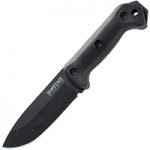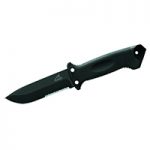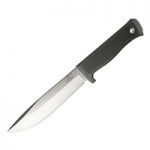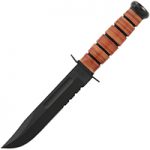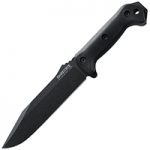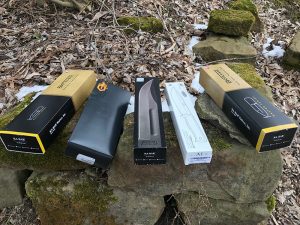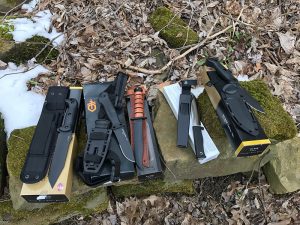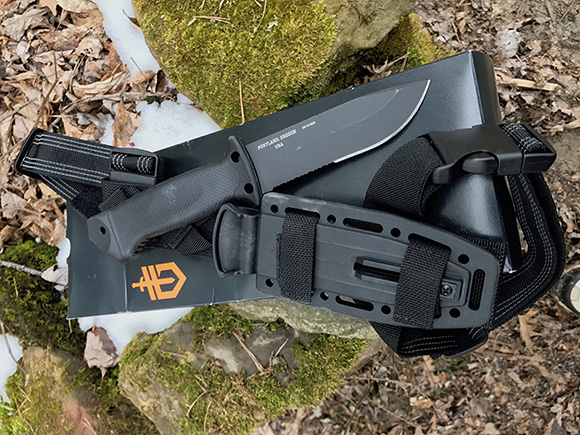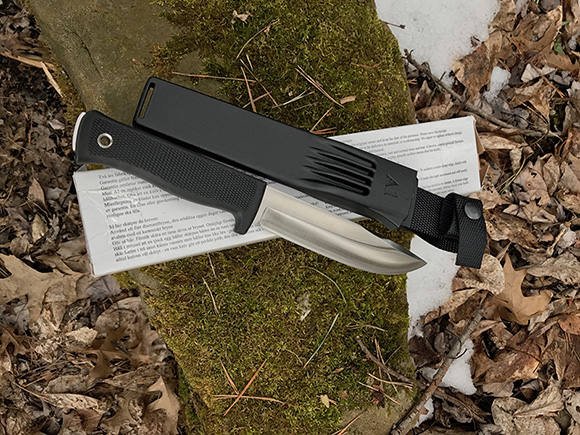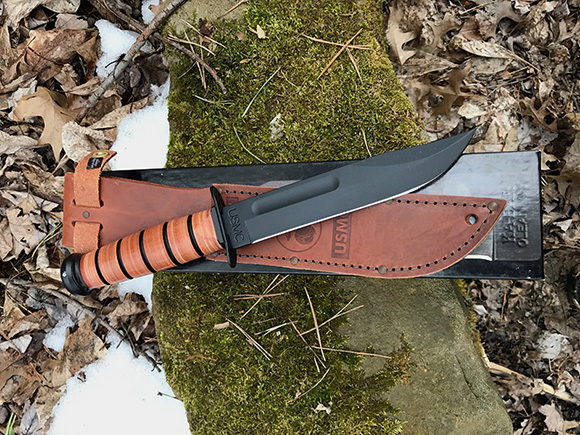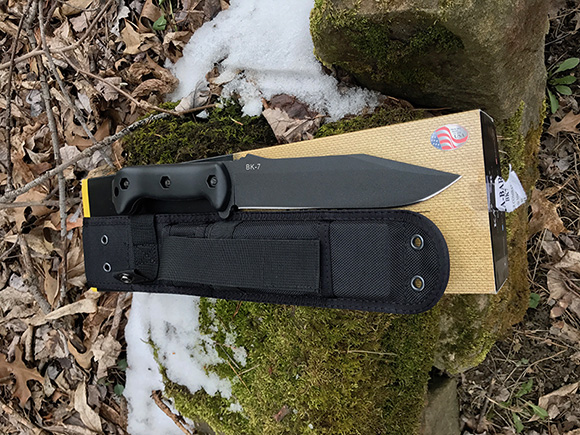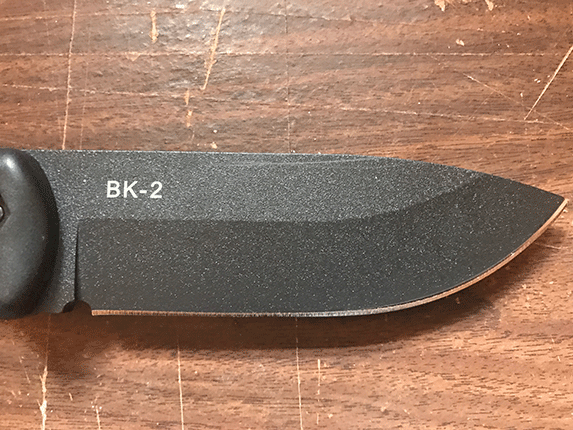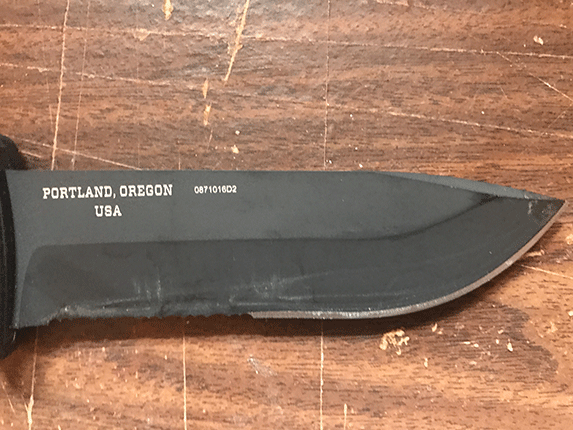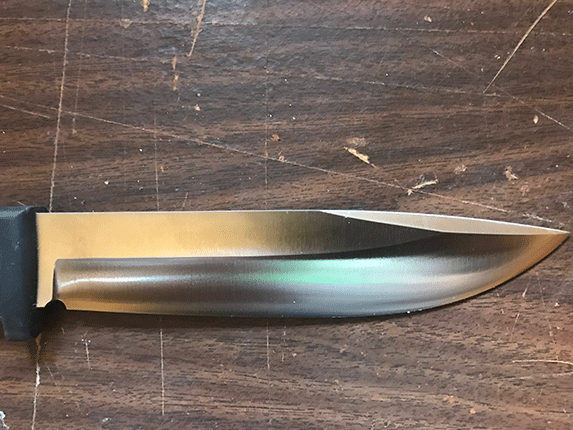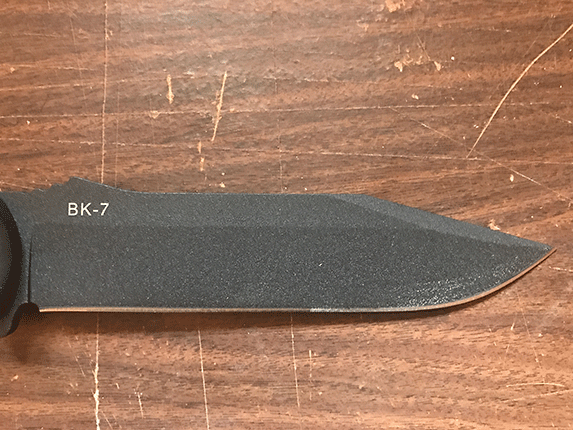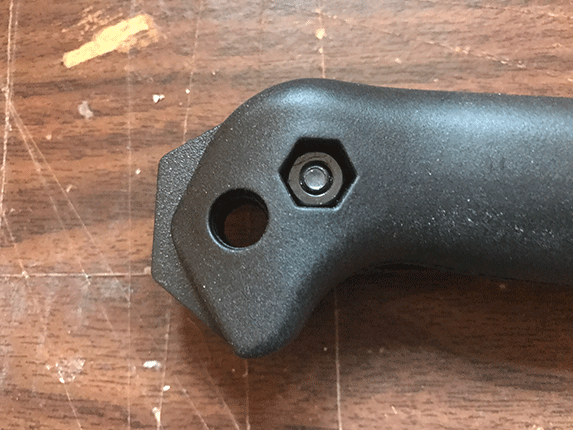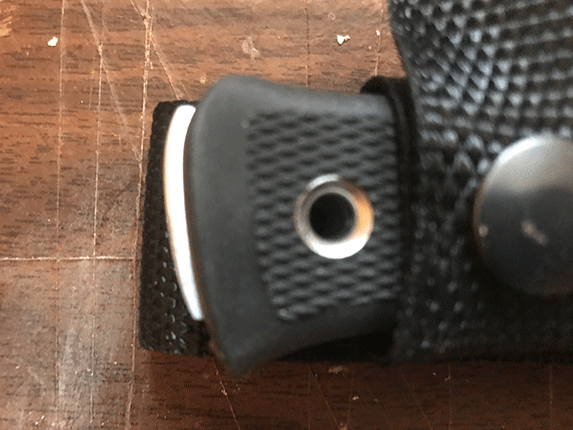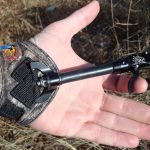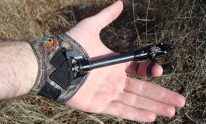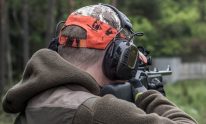Similar Articles
When you’re hunting, a few items are definitely your best friends. Your weapon, of course, whether it’s a gun, bow, or crossbow, is crucial. But before you can take that shot and after you’ve downed your prey, there’s an essential tool that you need to choose carefully: your hunting knife. You’ll use it to chop away limbs and branches in your shooting lane, as well as to field dress your game after you take it down.
That’s why it’s important to choose your hunting knife carefully. We’ve gone through hundreds of knives, and have narrowed the field down to the top five. Some are budget-friendly, some are more out there. Whatever your budget is, though, one of these knives is sure to suit your needs very nicely.
Top 5 Hunting Knives:
|
Check Price |
Check Price |
Check Price |
Check Price | KA-BAR BECKER BK7 COMBAT UTILITY KNIFE Check Price |
| T H E G O O D: | ||||
| Fantastic blade thickness. Great included sheath. Durable and rugged. | Super-sharp blade. Nice, pointy tip with enough ruggedness to stand up to use and abuse. Excellent texturing on the handle. | More corrosion-resistant than other knives in the lineup. Good length and thickness of the blade. Handles more like a thin-bladed knife than a thick-bladed one. | Very good for piercing, slicing, and chopping. Holds its edge well, while still being easy to sharpen. Thin enough for very delicate work, but still tough and strong. | Clip point for great piercing properties. Razor-sharp edge that holds well and is easy to sharpen. Nice length for chopping and slicing, but still good for delicate work. |
| T H E B A D: | ||||
| Handle is a bit short for folks with large hands. Very little texture on the scales. | Handle is a bit small for large hands. Serrated edges make blade difficult to sharpen. Included sheath uses noisy hook-and-loop straps to wrap around the handle. | Fairly expensive for what you get. Included sheath isn’t very good. No straight surface on the pommel for pounding. | Leather-wrapped handle is slippery. Included sheath is leather and easily punctured. | Almost no texturing on the handle allows it to get slippery. Might be considered too long a knife for some hunters. |
How We Tested the Hunting Knives:
When selecting the knives for our final five, we spent almost a hundred hours looking through product reviews and specifications. We consulted experts in hunting, survival, and knifemaking. We considered hundreds of models, and narrowed the field down to five.
With that done, we bought each of those five knives with our own money. We received zero of these products from the manufacturers.
back to menu ↑The 5 Hunting Knives We Selected For Testing
KA-BAR BECKER BK2 CAMPANION:
GERBER LMF II SURVIVAL KNIFE:
FALLKNIVEN A1 SURVIVAL KNIFE:
KA-BAR USMC FULL-SIZE KNIFE:
KA-BAR BECKER BK7 COMBAT UTILITY KNIFE:
back to menu ↑Our Expert Consultant:

David Polczynski is a former United States Marine and a Sigma 3 Certified Survival Instructor. He’s enjoyed being a wilderness school teacher, homesteader, die-hard entrepreneur, and much more. After spending some time in corporate America, then launched Ultimate Survival Tips LLC to help bring his two decades of outdoor, prepper and practical survival experience to high value, premium, broadcast-quality content to others.
What Did We Look For In A Hunting Knife?
Throughout the entire process of reviewing knives for our recommended Top 5, we looked at the following characteristics. These factors, along with others’ reviews and the advice of our experts, influenced our selection of the knives to test in the field. Once we narrowed down the list of knives, we continued to use these characteristics to guide us as we tested the knives.
Fixed Blade Knives Are Best For Outdoors Tasks
Folding knives are great for some situations, but when you’re out in the bush they just aren’t safe. Folding knives can break, leaving you without a reliable knife. They can also accidentally close, potentially injuring you in the process.
Full Tang Is Crucial
The tang is the portion of the knife steel that is held within the handle. To cut costs, many knife makers will design partial tang knives, where the tang only inserts partway into the handle. This is flimsy and can lead to a broken knife under heavy usage. Stick with full tang knives, where the tang extends all the way to the knife’s pommel.
Look For A Four- To Seven-Inch Blade
You definitely want a decent length to your hunting knife’s blade, but don’t get carried away. A blade that is too long can make it difficult to dress small game or perform precision carving. On the other hand, a knife that’s too small won’t be much good at chopping wood. We recommend a blade length of 4 to 7 inches for best usefulness and reliability. David Polcynski, founder of Ultimate Survival Tips, had this to say about blade length:
Remember – a well-designed larger knife can do everything a small knife can do, but a small knife can’t do everything a larger knife can do.
Blade Thickness Is Important, Too
You don’t want your hunting knife to be prone to bending, so it needs to be relatively thick compared to your everyday carry knife. On the other hand, you don’t want the blade so thick you can’t use it for delicate work like carving snare sets or field-dressing game. The sweet spot in blade thickness for hunting knives is between 0.17 and 0.25 inches.
Consider The Style Of The Blade
Hunting knives need to be useful for a wide variety of purposes, so the style of the blade is very important. A clip point blade is very useful for piercing and provides a tip that can be useful as a pick or for cutting in tight places. Drop point blades are also ideal, since they’re still useful for piercing as well as slicing or chopping.
Type Of Steel Matters
For everyday carry knives, experts often recommend a good stainless steel. In the bush, though, stainless steel isn’t as durable. That’s why we looked for tough, high carbon steel alloys. 1095 Cro-Van is the most popular carbon steel used in hunting knives, and it’s what most of our selections use. The only “gotcha” with carbon steels is that you need to take good care of them with dry lubrication, or they’ll rust and stain.
It Should Be Easy To Sharpen In The Field
This is the reason 1095 Cro-Van is so popular; it’s durable and rugged, but it’s also easy to sharpen in the field. You want a tough grade of steel, but you also want to be able to fine-tune your knife’s blade when it gets a bit too dull for the task at hand.
The Grip Is Important
The knife’s handle, or grip, is very important. You want something that you can hold and use in poor weather conditions without getting uncomfortable. You also want the handle to stay comfortably in your hand without slipping.
A Solid Pommel Is Crucial
The pommel is the very end of the knife handle, also called the butt. For a good hunting knife, you really want something with a flat edge you can hammer on if you need to drive your knife into a tough material to break it or cut it.
Look Carefully At The Knife Tip
Next, we’ll look at the tip of the knife. You want something that can pierce easily, for beginning to field dress your game. You also want the tip to be durable, in case you need to drive the tip into wood or another hard material.
How Good Is The Knife At Chopping and Splitting?
When you’re scouting hunting locations or getting a spot set up, you will often need to clear branches and brush from your shooting lanes. Unless you really want to carry a machete, too, you’ll want your hunting knife to be good at chopping. For those nights at the hunting camp, you might also need to use your knife to split wood, so we’ll look carefully at how useful each knife is at these tasks.
How Useful Is The Knife For Fine Detail Work?
In the bush, you sometimes need to do more intricate knifework. Perhaps you need to carve a snare, or fashion a spear. We’ll check out each knife’s capability at carving, and report on that.
Don’t Forget The Knife’s Sheath
Expert David Polcynski points out something we totally agree with. He says, “I’m not sure why so many companies develop a great knife, only to put it in a crappy sheath.” You want the sheath for your knife to protect it and help you carry it, but there’s so much more to consider here: built-in sharpeners, flexibility in carry, and the ability to attach other accessories to the sheath. We’ll look carefully at the sheaths for each of our knives, and let you know how each one stacks up.
Now that you know what we looked at for each knife, let’s move on to the nitty-gritty – the actual tests.
back to menu ↑Make Sure It Has A Fixed Blade
Because a fixed blade knife is an absolute must-have in a hunting knife, we made sure each one of the knives we selected for testing featured a fixed blade. Watch the video below for more information about fixed blade knives, and a demonstration of why it’s important.
back to menu ↑Avoid Partial Tang Knives – Stick With Full Tang
Again, this is a characteristic we didn’t make any exceptions for. Each and every knife we selected has a full-length tang, because nothing less is suitable for outdoors tasks.
back to menu ↑Blade Length – 4 To 7 Inches Is The Way To Go
You definitely want a good length to your knife’s blade, from four to seven inches. Each of the knives we evaluated provides this. Here’s the length of each knife’s blade.
The Ka-Bar Becker BK2 Campanion
The Campanion’s blade is 5.25 inches long, right in the middle of our recommended length. It actually feels a bit on the short side to us, compared to its big brother, the BK7. It’s still a decent length, though, and is able to do everything I need it to do in the field. Chopping with the BK2 isn’t quite as easy as with longer blades, though.
The Gerber LMF II Survival Knife
The LMF II’s blade measures 4.84 inches in length, and is definitely on the short side of what I like to see. Chopping with this blade is a challenge, since your swing has to take you very close to what you’re trying to chop. For fine detail work, though, the LMF II is a pleasure to use.
The Fallkniven A1 Survival Knife
This knife’s blade is 6.3 inches long, offering plenty of room for swinging and chopping. It’s nicely balanced, and the blade has a sharp enough edge to make quick work of tree limbs and branches.
The Ka-Bar USMC Full-Size Fighting Knife
This one features a blade that measures almost exactly seven inches in length. This length is almost perfect for hunting tasks, since it’s long enough to make swinging and chopping easy but still short enough to handle fine-detail work with ease.
The Ka-Bar Becker BK7 Combat Utility Knife
The BK7 is another knife with a blade almost precisely seven inches in length. It has a beautiful swing to it, works great for chopping. At the same time, it’s also wonderful for close-up work like making snare sets or chopping tomatoes in the camp kitchen.
back to menu ↑Blade Thickness – 0.17 To 0.25 Inches Is Preferred
Next up, the thickness of the blade. You need enough thickness to stand up to heavy-duty tasks, but the blade still needs to be thin enough for finely detailed work like skinning game in the field. Here is information on each blade’s thickness:
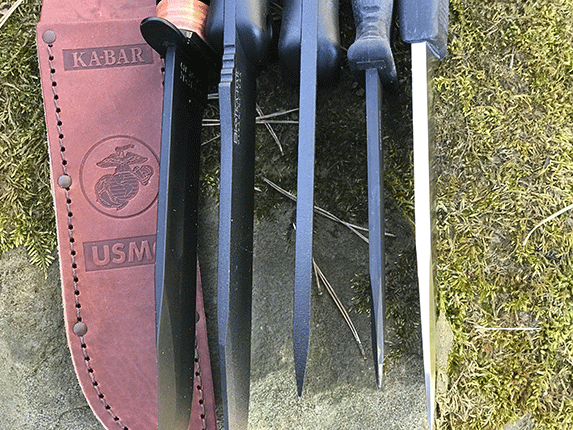
Here you can see how thick all of the knives are. From left to right, pictured: Ka-Bar USMC Full-Size Fighting Knife (0.24 inches), Ka-Bar Becker BK2 Campanion (0.25 inches), Ka-Bar Becker BK7 Combat Utility Knife (0.188 inches), Gerber LMF II Survival Knife (0.1875 inches), Fallkniven A1 Survival Knife (0.1875 inches)
The Ka-Bar Becker BK2 Campanion
Ka-Bar’s Campanion is a quarter of an inch (0.25 inch) thick, making it the thickest blade of the bunch. This is surprising, given its relatively short length, but we found that the BK2 worked wonderfully for almost every task. A quarter of an inch in width is great, but you might find it a challenge to use in skinning very small game. We were able to make it work, but it required a lot of focus and care in not allowing the blade to work its way too deep into the meat of the animal.
The Gerber LMF II Survival Knife
Gerber seems to have found the sweet spot here, with a blade 0.1875 inch thick. The blade is thick enough to prevent bending or breaking, but it’s still thin enough to skin and slice delicately without any difficulty. We’ve used the LMF II for everything from splitting wood to dicing onions, and it has never let us down.
The Fallkniven A1 Survival Knife
With the Fallkniven A1 Survival Knife, we find another example of a thick-bladed knife. The thickness of this blade is 0.24 inch, almost a full quarter-inch. Handling this beauty, though, you might not believe it was quite so thick. It slices and dices with ease, but it’s still plenty thick enough for prying work without fear of the blade bending or breaking.
The Ka-Bar USMC Full-Size Fighting Knife
Because of its reputation, we fudged a bit on the thickness requirements when looking at the Ka-Bar USMC Full-Size Fighting Knife. This one’s blade measures just 0.165 inch thick, but it’s still a fairly robust knife. It chops, slices, and dices with ease. While we didn’t manage to break the knife by using it as a pry tool, it’s slenderness definitely makes it less useful in that task than the other knives we evaluated.
The Ka-Bar Becker BK7 Combat Utility Knife
Another Ka-Bar Becker creation, the BK7 Combat Utility Knife has a long, tapering blade that is only 0.188 inch in thickness. It offers great handling when doing fine detail work, especially given its long blade, simply because the knife is thin enough to get really precise with your carving or slicing. At the same time, the blade is thick enough to handle quite a bit of prying, never once failing us in our tests.
back to menu ↑Look Carefully At The Style Of The Blade
You want to make sure your hunting knife is shaped right for the type of jobs you’ll be doing and for being able to easily care for it in the field. It needs to have a long, fairly straight edge for slicing and chopping. That straight edge also makes it easier to sharpen, since you don’t have to work around curves. Still, the tip needs to be useful for piercing while also being strong enough not to chip or break.
We really like decent clip point blades in our hunting knives. This blade shape, if done right, offers terrific piercing properties, but is still resistant to chipping or breaking the tip. That’s crucial when hunting.
A good drop point blade is also good for a hunting knife. You still get some taper in the insertion point of the knife, and some would argue that the broader surface makes it even better.
The Ka-Bar Becker BK2 Campanion
Let’s look first at the Ka-Bar Becker BK2 Campanion. It features a drop point design with a sharp tip for piercing. This blade doesn’t have quite as fine a point as the others, making it much more resistant to chipping and breaking. However, it also doesn’t prove to be as useful for piercing as the other knives in the lineup.
The Gerber LMF II Survival Knife
The drop point design of the Gerber LMF II Survival Knife is very rugged, but it’s still quite useful for piercing. The partial serration on the blade edge is terrific for sawing through larger branches or limbs that you can’t just chop, but the serrated edge comes at a cost: it’s every-so-slightly more difficult to sharpen the cutting edge of the blade.
The Fallkniven A1 Survival Knife
The Swedish-made Fallkniven A1 Survival Knife is another example of a drop point blade design. This one is also described as a modified spear point, thanks to the tapered top edge of the blade leading into the knife tip. The A1 is very good at piercing objects, but the tip still has enough breadth to prevent you from inadvertently breaking or chipping it.
The Ka-Bar USMC Full-Size Fighting Knife
The most famous fixed blade knife in the world also features a clip point blade. The USMC Full-Size Fighting Knife’s tip is tapered nicely for piercing, but it’s still strong enough not to clip or break easily.
The Ka-Bar Becker BK7 Combat Utility Knife
The Ka-Bar Becker BK7 has the best style of clip point we’ve seen, since it works great for piercing but it’s still broad enough not to easily chip or break. Believe me, we tried to break the tip on the BK7, and couldn’t. This blade also offers plenty of length for chopping and slicing, with a terrific flat edge that makes working with even larger items a breeze.
back to menu ↑Tough Type Of Steel
As we explained earlier, the steel in your hunting knife should be tough and rugged. Since these knives are used less frequently than your everyday carry knife, low-maintenance isn’t usually a factor. A steel with a high carbon content will be harder than most stainless steels, but not as corrosion-resistant. Just remember to apply some dry lubricant to the blade every so often, particularly after using it, and you’ll be fine.
Most of the knives we selected feature high-carbon steel. The three Ka-Bar knives all utilize 1095 Cro-Van, and the Gerber LMF II Survival Knife is made from 420HC stainless steel. The “HC” in the name stands for “high carbon,” which is what we’re looking for. Fallkniven’s A1 Survival Knife also makes use of stainless steel, but again a variety with a high carbon content: laminated VG10. If you like the A1 but want a less reflective surface and tougher blade, consider purchasing it with the black CeraKote option.
back to menu ↑Ease Of Sharpening In The Field
No matter how hard your blade is, it’s going to get dull with use. When you’re selecting a hunting knife, you want to ensure your knife will be easy to sharpen in the field. This factor relies on the type of steel used as well as the shape of the blade. 1095 Cro-Van steel is hard enough to help the blade keep its edge nicely, but it’s still relatively easy to sharpen. The same is true for Gerber’s 420HC and Fallkniven’s laminated VG10.
The shape of the blade, as mentioned, also factors into how easy the knife is to sharpen in the field. Of all of the knives we selected for testing, almost none of them featured serration on the blade. This was intentional, because serrated or partially-serrated blades can make it much more difficult to sharpen the knife. We made an exception in the case of the Gerber LMF II Survival Knife because of the built-in blade sharpener in the sheath, which helps tremendously.
back to menu ↑Grip: Handle Material And Design
The handle of your hunting knife isn’t something to ignore. You’ll be holding and using the knife for tough work, and for extended lengths of time. You’ll also be using the knife in inclement weather conditions, so it needs to have plenty of grip. It also needs to be very durable, so it doesn’t break on you. Modern synthetic materials are usually best for handles. Kraton, a synthetic rubber polymer, is great, as is a glass/fiber reinforced nylon material like Zytel or Valox.
The Ka-Bar Becker BK2 Campanion
The handle on this knife is made from a high-density plastic called Ultramid. This material is very tough and durable, but it doesn’t offer much texture. While we didn’t notice any problems with the knife flying out of our hands, it definitely slipped around more than we were comfortable with. Finally, the handle is a bit on the short side – it’s quite comfortable if you have small- or medium-sized hands, but if your paws are larger than average, you might not be able to grip the knife very comfortably. If you like attaching a wrist strap to your knife, you can easily do that using the lanyard hole near the pommel.
The Gerber LMF II Survival Knife
Gerber has built the handle on the LMF II Survival Knife out of glass-filled nylon with a TPV overmold. This means you have a solid, rugged handle that feels soft to the touch. It’s also got plenty of texture, helping maintain a positive grip on the knife even when your hands are slippery. The only drawback here is that, once again, the handle might be a bit on the small side for folks with larger-than-average hands. Here, too, you have a lanyard hole for lashing a wrist or hand strap to the knife.
The Fallkniven A1 Survival Knife
Fallkniven has used Kraton, a synthetic rubber, for the handle on the A1 Survival Knife. Kraton has great resistance to heat, weathering, and chemicals, and the handle offers plenty of texture for maintaining a sure grip on the knife. There’s not much ergonomic design built into the handle, but we didn’t notice any hot spots or other problems with using the knife for extended periods. The handle also features a lanyard hole.
The Ka-Bar USMC Full-Size Fighting Knife
The handle for the USMC Fighting Knife is leather-wrapped and slightly bulging to accomodate a good grip. It offers ridges to help provide you with a solid hold on the knife, but unfortunately that just isn’t enough. The leather is too slippery for use when your hands are wet or it’s icy. The only saving grace here is the large quillon, or guard, which prevents you from sliding your hand down over the sharp edge of the blade.
The Ka-Bar Becker BK7 Combat Utility Knife
The handle on Ka-Bar’s Becker BK7 Combat Utility Knife uses Ultramid, just like the BK2. Sure, it’s tough and durable, but the lack of texturing does make it slide around a bit. The rounded front and back edge of the handle helps quite a bit with that, providing stops to prevent your hand from sliding too much. This handle is a great size, even for those with larger than average hands. Once again, a lanyard hole is present for attaching a rope or strap to your knife.
back to menu ↑Make Sure Your Knife Has A Solid Pommel
The pommel, or the butt, of your knife should be solid and, preferably, flat. You’ll use this edge to strike your knife when you need to drive the blade point-first into a hard object. This might happen because you need to pry something, or you’re trying to split a piece of wood.
The Ka-Bar Becker BK2 Campanion
Ka-Bar hasn’t done anything radical or special with the pommel of the BK2 Campanion, but it’s certainly one of the better ones out there. It features a nice, broad straight edge for striking with a mallet or hammer. You don’t have to worry about your hammer slipping off the pommel and hitting your hand with this one.
The Gerber LMF II Survival Knife
Gerber did something radical for the pommel of the LMF II Survival Knife. The knife was designed with military troops in mind, particularly helicopter pilots. The pommel features a pointed tip that can be used to shatter the Plexiglass of a helicopter canopy. Unfortunately, this isn’t much good in a hunting situation. Yes, there’s still a straight edge for striking the pommel with a mallet or hammer, but that edge is at an angle that could lead your hammer to sliding down and hitting your wrist or arm.

The pointed tip of the Gerber LMF II Survival Knife’s pommel is great for breaking glass or Plexiglass, but not so much for use as a hammering surface
The Fallkniven A1 Survival Knife
Here’s an example of a knifemaker seeming to put form before function. The gently sloped pommel extending behind the handle may follow the contour of the scales, but it doesn’t provide a very flat striking surface for use with a hammer or mallet. It’s also rather slippery, so we wouldn’t feel comfortable trying to pound the A1 into an opening to split an object or pry things apart.
The Ka-Bar USMC Full-Size Fighting Knife
This is another rather plain pommel, but one that suits its purpose just fine. In fact, maybe better than fine. The flat surface of the USMC Fighting Knife’s pommel looks and feels just like the head on a nail, and it works the same way. You won’t have to worry about your hammer or mallet slipping off the edges, and can pound away comfortably for as long as you need to.
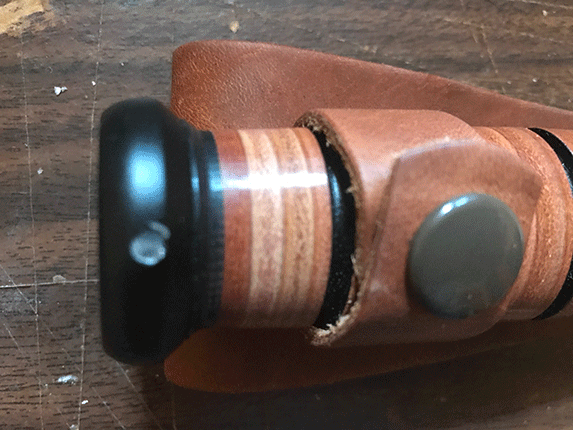
While not exactly exciting, the pommel on the Ka-Bar USMC Full-Size Fighting Knife is definitely useful
The Ka-Bar Becker BK7 Combat Utility Knife
Like the smaller BK2, the Ka-Bar Becker BK7 has a straight edge to the pommel that is perfect for pounding. It takes a beating, and never bends or breaks. You can use your mallet or hammer to drive the BK7 into just about anything softer than the steel itself, and never have to worry about the object sliding off the edge and hitting you.

Like the smaller BK2, the Ka-Bar Becker BK7 Combat Utility Knife offers a terrific striking edge on the pommel for hammering the knife into or between objects
Usefulness For Chopping And Splitting
No matter how long your hunting trip is, your knife of choice needs to be good for chopping and splitting. You will need to clear tree limbs and branches from your shooting lanes, and might even need to chop away a spot to put your ground blind or tree stand. For longer excursions, a good hunting knife can also be invaluable for chopping and splitting firewood. Sure, you’ll probably have an axe along on a longer hunting trip, but your knife should be useful as a backup in case you lose your axe or it breaks.
The Ka-Bar Becker BK2 Campanion
For splitting, the Campanion is great. The tough, durable blade is sharp enough to handle the most stressful splitting jobs with ease, as long as the logs weren’t too thick. When it comes to chopping, though, we found the blade to be a bit on the short side. We could chop with it, but had to get closer than we were really comfortable with to pull the job off.
The Gerber LMF II Survival Knife
If the BK2 was tough for chopping, the LMF II was even worse. The blade was just too short to be truly effective at chopping limbs and branches safely. Gerber’s survival knife works great for splitting wood, though. Call it a personal preference, maybe, but it seems that longer blades are just better suited to chopping tasks.
The Fallkniven A1 Survival Knife
Next up, the Fallkniven A1 Survival Knife. This blade’s length makes it ideal for chopping, but the VG10 stainless steel isn’t as rugged or durable as other high carbon steels. The blade wore down pretty quickly, and had to be sharpened after heavy chopping tasks. The addition of the CeraKote coating might be useful here, though.
The Ka-Bar USMC Full-Size Fighting Knife
This long-bladed knife wasn’t really designed with chopping in mind, but it still does a great job of it. It handled clearing brush, limbs, and branches from our shooting lanes with ease, even when we were dealing with hardwoods. The USMC Fighting Knife also kept a sharp edge really well during chopping tasks, making it one of the best knives for that task.
The Ka-Bar Becker BK7 Combat Utility Knife
The BK7 turned out to be the best knife for chopping and splitting. The long blade length and the use of 1095 Cro-Van steel make an excellent combination, giving you a blade that offers a great swing for chopping while also maintaining a razor-sharp edge. The BK7 is also terrific for splitting wood, since it’s long enough to handle even thick logs with ease.
back to menu ↑Usefulness For Fine Detail Work
It’s not all rough and tumble work when you’re hunting. Sure, you have to do plenty of chopping and splitting with your hunting knife, but there’s also plenty of more finely detailed work to be done. Whether you’re skinning small game, slicing tomatoes or onions in the camp kitchen, or fashioning a snare set, you want your hunting knife to be able to handle delicate work with ease.
The Ka-Bar Becker BK2 Campanion
Carving and shaving wood with the BK2 Campanion is easy, and the short blade length makes it almost natural to do finely detailed work. Sometimes, though, this knife’s blade thickness gets in the way. We could use the knife for skinning small game like rabbits and squirrels, but it really required a lot of attention to detail. The same held true for making snare sets. We could do the jobs, but it was more painstaking than with a thinner blade.
The Gerber LMF II Survival Knife
With the Gerber LMF II Survival Knife, we almost found the sweet spot when it came to performing intricately detailed tasks. The blade was sharp enough to shave thin slices, and thin enough to make skinning small game an easy task. So, what’s the problem? If you don’t pay attention to what part of the blade you’re using, it’s easy to slip up and let that serrated back edge of the knife tear up what you’re working on. Something to be aware of, and a reason that we wish the LMF II was available without the partially serrated blade.
The Fallkniven A1 Survival Knife
This Swedish knife is fairly thick, but don’t let that girth fool you. We found the Fallkniven A1 Survival Knife handled as if it was much thinner, allowing us to tackle fine detail work with ease. It just doesn’t feel as thick as it looks, for some reason. You still have to pay a bit more attention to what you’re doing when you’re skinning small game, but not as much so as with other blades with a similar thickness.
The Ka-Bar USMC Full-Size Fighting Knife
Once again, we’re using the USMC Fighting Knife for something it wasn’t really designed for. After all, this knife was originally intended for fighting, but since then has become extremely popular for adventurers, survivalists, hunters, and more. This isn’t an accident, in our opinion. The shape of the blade and the sharp tip make it perfect for both heavy-duty tasks and finely detailed jobs. The only drawback is the leather-wrapped handle – if you’re in the rain or ice, the handle tends to get a bit slippery. Luckily, you’ve got a very broad quillon, or guard, to prevent your hand from slipping down over the sharp edge of the blade.
The Ka-Bar Becker BK7 Combat Utility Knife
Finally, the Ka-Bar Becker BK7 Combat Utility Knife doesn’t look like it would be useful for intricate work, but it certainly is. The blade is thick enough to have plenty of strength, but also thin enough to handle fine detail work with ease. Even though the blade is seven inches long, the finly pointed tip makes it easy to perform intricate carving and piercing.
back to menu ↑Sheath System
Now, for the sheath you hold and carry your hunting knife in. Some manufacturers get this completely right, but the majority tend to leave something to be desired. This is unfortunate, since it often means you have to spend even more money on a custom sheath for your hunting knife.
The Ka-Bar Becker BK2 Campanion
The Ka-Bar Becker BK2 Campanion is available with either a hard plastic or heavy-duty polyester sheath with front pocket. Both sheaths are MOLLE-compatible, and both offer great retention of your knife. The hard plastic sheath has multiple lashing points and a belt loop. The knife “clicks” into place, and requires a good bit of force to remove it – it won’t just fall out of the sheath, that’s for sure. There’s also a snap fastener to wrap around the knife’s handle, offering additional security.
If you opt for the polyester sheath, you get multiple lashing points (but not as many as the hard plastic sheath) and a belt loop. There are also snap fasteners to wrap around your knife’s handle and keep it from falling out of the sheath. Finally, the front pocket on the sheath is great for stashing small items like a flint or small sharpener.
The Gerber LMF II Survival Knife
Gerber should know the importance of a good sheath, but they just didn’t get things quite right with this one. Yes, the sheath for the LMF II is MOLLE-compatible, made from a durable plastic, and includes a built-in sharpener. The sheath also does a great job of retaining your knife, if you remember to feel for the “click” when the blade is fully enclosed. However, Gerber used a heavy-duty hook-and-loop closure system on the handle wraps of the sheath. These make a lot of noise, something you should avoid when you’re in a hunting or survival scenario.
The Fallkniven A1 Survival Knife
If all you wanted was a simple Zytel sheath to hold your knife, the one that comes with the Fallkniven A1 would be perfect. Unfortunately, for a hunting knife, you usually want a bit more flexibility and utility. Built-in sharpeners are great, as is MOLLE-compatibility. This sheath offers neither; it’s just a plastic casing that you slide your knife into. It has a belt loop and a snap fastener to wrap around and secure the handle of the knife. Definitely not our favorite. There is an option for a leather sheath, but it’s no better.
The Ka-Bar USMC Full-Size Fighting Knife
For the Ka-Bar USMC Full-Size Fighting Knife, you only get once choice of sheath: a treated leather sheath. It’s a gorgeous sheath, but it lacks much in the way of utility. It’s not MOLLE-compatible, and it only offers a belt loop for securing the sheath to your body. Here’s the part that’s even worse, though: the sheath isn’t sturdy enough to stand up to the blade you insert into it. In fact, the sheath is so tight out of the box that we put our blade completely through the back of it, almost getting sliced up in the process.
The Ka-Bar Becker BK7 Combat Utility Knife
The sheath that ships with the Ka-Bar Becker BK7 Combat Utility Knife is the best one we’ve seen. It’s made from heavy-duty polyester and is MOLLE-compatible. The wrap for around the handle fastens with a snap buckle that makes very little noise, and the sheath has a front pocket for storing small items like flint, sharpeners, or even the skeleton-handled Ka-Bar Becker Remora knife. < back to menu ↑
The Best Of The Best In Hunting Knives
Our favorite hunting knife has to be the Ka-Bar Becker BK7 Combat Utility Knife. It’s made from tough1095 Cro-Van steel, which holds a sharp edge nicely but is still very easy to sharpen in the field. The BK7 has a wonderful clip point blade that is terrific for piercing, and the straight edge offers plenty of room for chopping and slicing. The handle offers a lanyard hole, and the pommel has the straight, hard surface necessary for those times when you need to pound the blade between an object or between things. The included sheath is durable and MOLLE-compatible, and even offers a front pocket. The only real drawback to the BK7 is that the handle doesn’t have much texture.
The Runner Up For The Best Of The Best
If you prefer a smaller blade than the seven-inch one found on the BK7, Ka-Bar’s Becker BK2 Campanion is a very close second in our eyes. The BK2’s blade is fashioned from 1095 Cro-Van steel, so it’s going to hold a sharp edge even under hard usage, while still being relatively easy to sharpen in the field. The drop point blade isn’t as good for piercing as a clip point, but it still works nicely in that regard. The handle has a lanyard hole, and the pommel has the same straight edge as found on the larger BK7. This model comes with a durable hard plastic sheath, but you can also get it with a durable polyester sheath with front pocket. Both sheaths are MOLLE-compatible. The two main drawbacks with the BK2 are its rather short handle length and the lack of texture on the scales.
Tips & Tricks For Buying a Hunting Knife
As you can see from the prices on most of the hunting knives we evaluated, you don’t have to pay an arm and a leg to get a good hunting knife on a tight budget. With that said, remember that this is an investment in a tool that will be almost as important in the field as your gun, bow, or crossbow. Follow these tips and tricks, and you should be able to make a sound investment.
- Ensure that the knife is a fixed blade design, with a full tang.
- Make sure it utilizes high carbon steel. Examples of this include 1095 Cro-Van and 5160 steel. For stainless steel options, look for 420HC, laminated VG10, AUS–8, and AUS–10 as the blade material.
- Stick with drop or clip point blade shapes. Fancier blade designs have their advantages, but often lead to difficulty sharpening the edge in the field.
- Look at the knife tip as well as the blade thickness – will you be able to pierce hard objects without worrying about the tip breaking?
- Make sure the pommel features a good striking surface.
- Unless you really want to purchase a custom sheath, make sure the survival knife you choose comes with a great sheath that offers plenty of flexibility.

